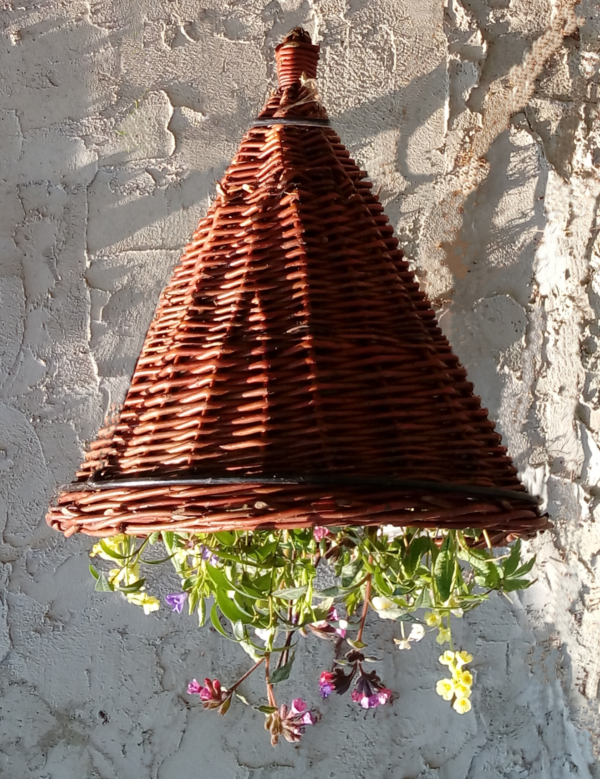 |
 |

|

|
|
|
| In the end of April,
in the year of pandemic, the Congress of Conology
didn’t take place. No matter how bizarre it might seem, it was not more bizarre than many a congress. Conology is an unknown branch of science and the congress was to begin its triumphant march through margins of all kinds. Many a congress had an incomprehensible topic. Many a congress was cancelled and didn’t take place at all. Many a congress was unnecessary. The good reason to arrange the congress was the presentation of TUSCONY. Of course, the book has not been presented, because there was nobody it could be presented to. So, it can be written straight and with no hidden intentions that nobody liked the book. With no doubt it would be better if the book had not been written at all, or at least not printed on time. Alas, the book was written, and a few copies printed on time, even in advance. The presentation would be very short, because just this book doesn’t need a special manual, it’s quite intuitive to be handled. Since Tuscony is the first attempt to describe the conical world with triangular base, it seemed to deserve something like a congress, all the more this attempt was not successful, really, in fact rather awful. The congress was to initiate serious and fruitful studies that would result in much better descriptions of this phenomenon. Unfortunately, K.M., the renown connoisseur of antiquity, the translator of Eucid, Heraclitus and Parmenides, did not give a lecture on Archimedes and his conoids (or on something else – Archimedes as a choice seemed obvious, hence banal, while K.M. doesn’t look like someone whom banal obviousness can satisfy, really not). J.S., my university friend, eminent connoisseur of architecture, urban design and political labyrinths, didn’t tell anything about conical buildings, neither reversed nor turned, and about their hidden presence everywhere, either. S.Z., an expert on art and digital (conical?) photography, didn’t prove the superiority of conical brushes over the cuboid ones, so we don’t know if this was really what she wanted to prove. K.S., an excellent gambist didn’t play the concert and thus convinced nobody that viola da gamba is an ideal instrument to play the conical music; we don’t know, either, which variant he had chosen, or maybe would proposed something that had not been described in the book. Only R.N. showed in the garden four samples of big (non)classical Tusconian liBerature – he didn’t show in the house any samples of the small liBerature, what a pity - was he lazy or not convinced? The first one was quite good, though the place for the text was chosen casually: 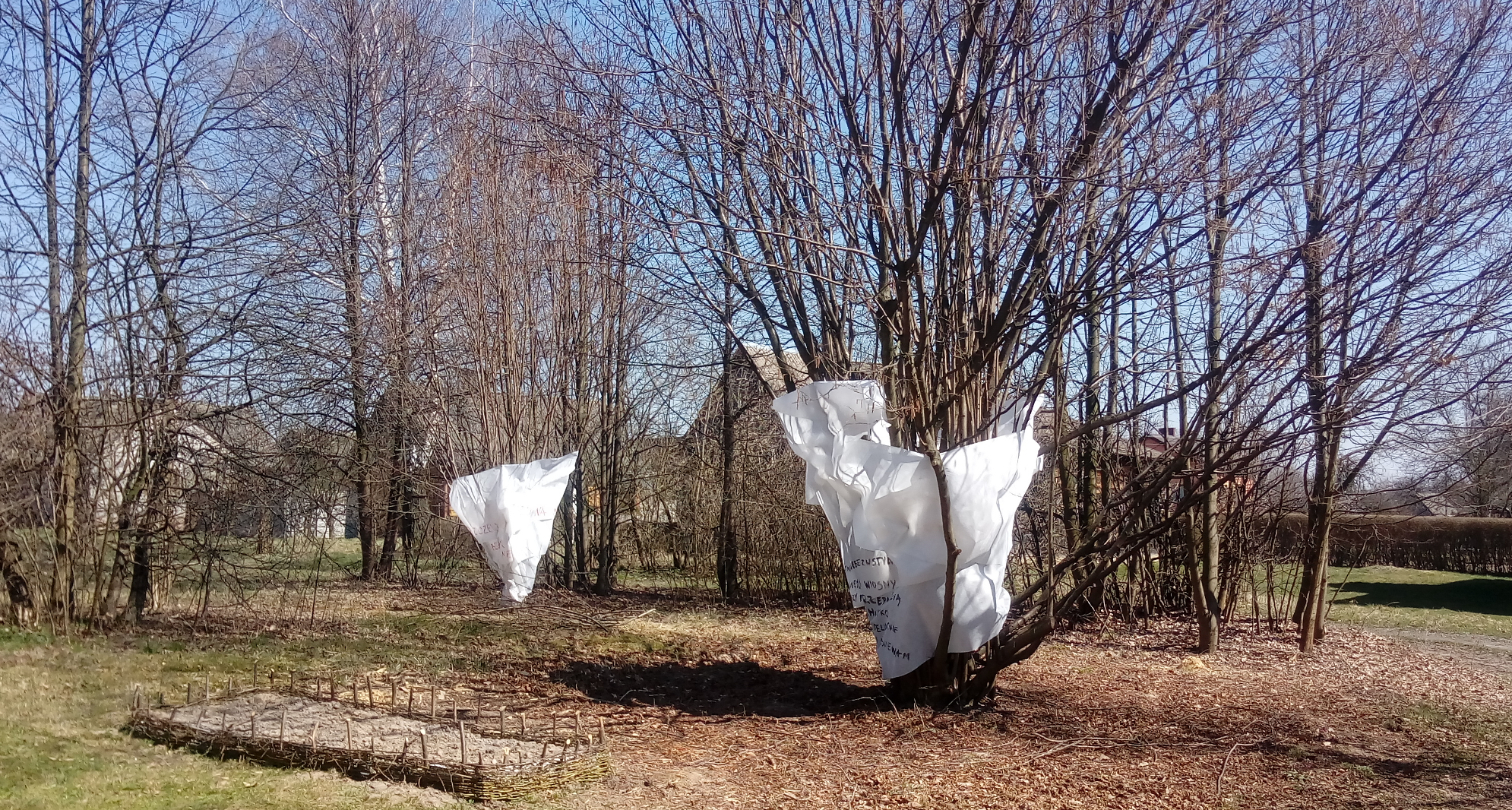 |
|
leafless not shameless at the precipice of drought on the edge of spring I delight unwittingly I shine delicately I rustle silently |
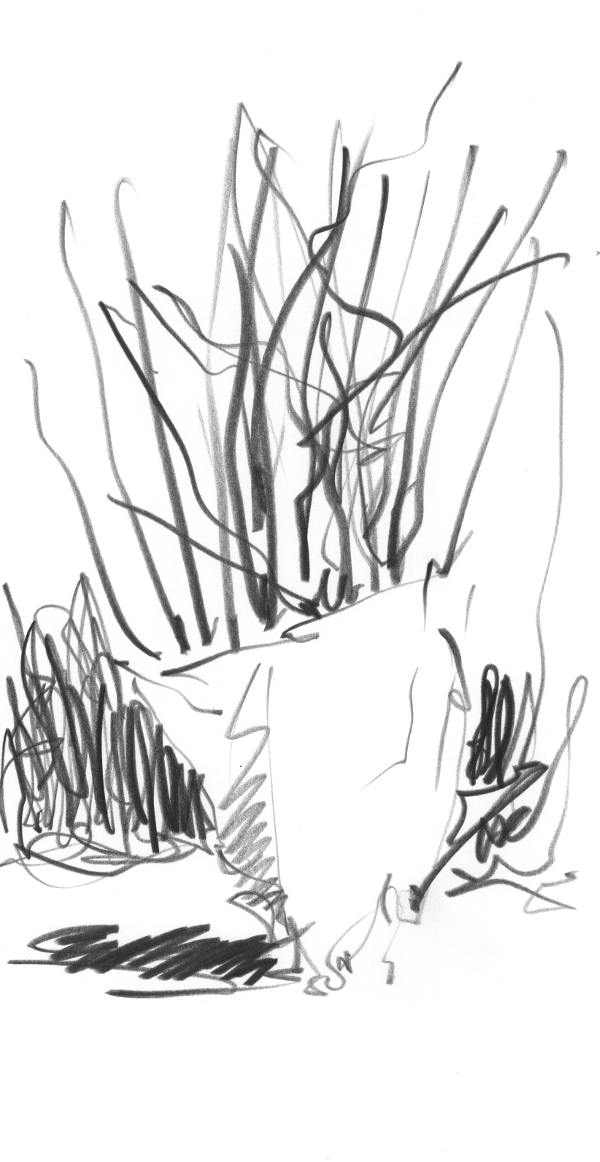 |
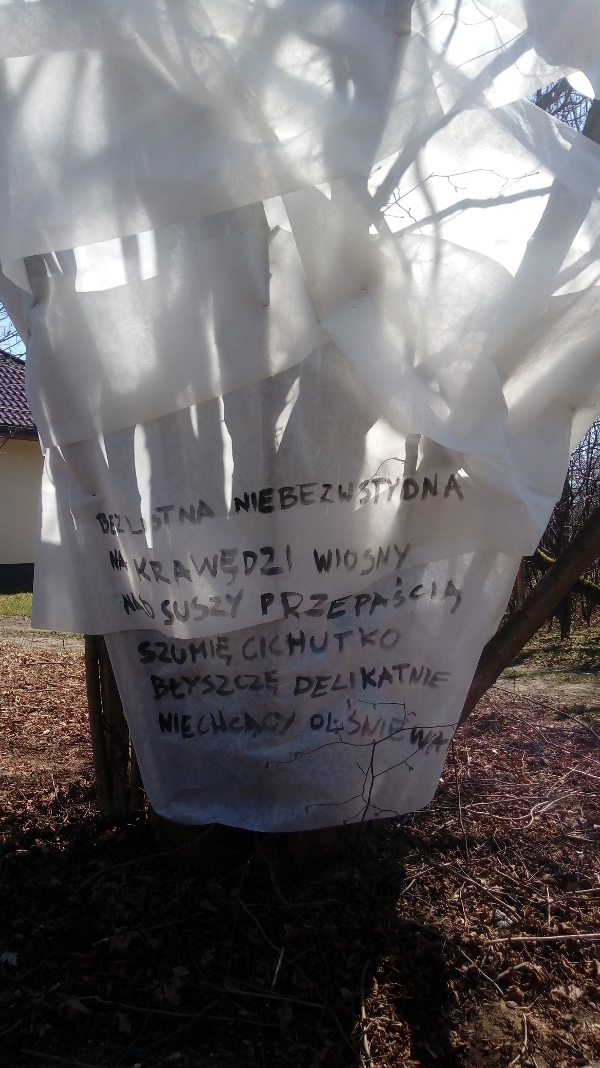 |
|
The second was much worse,
mainly due to the fact the text was not a ring, the
last word dropped off and spoiled the effect. The play of words makes the
translation impossible and useless. |
 |
 |
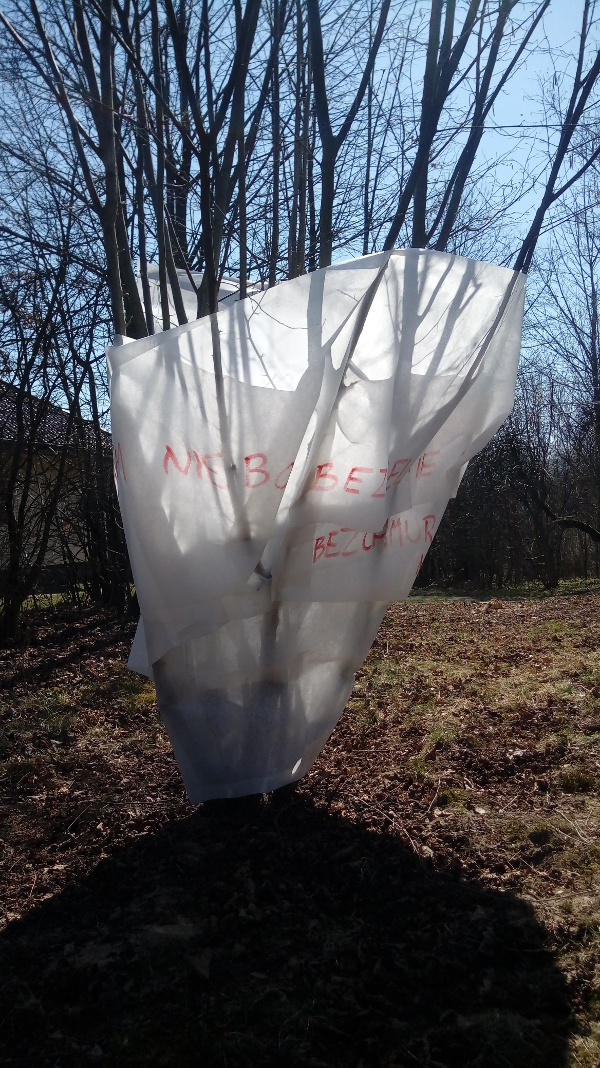 |
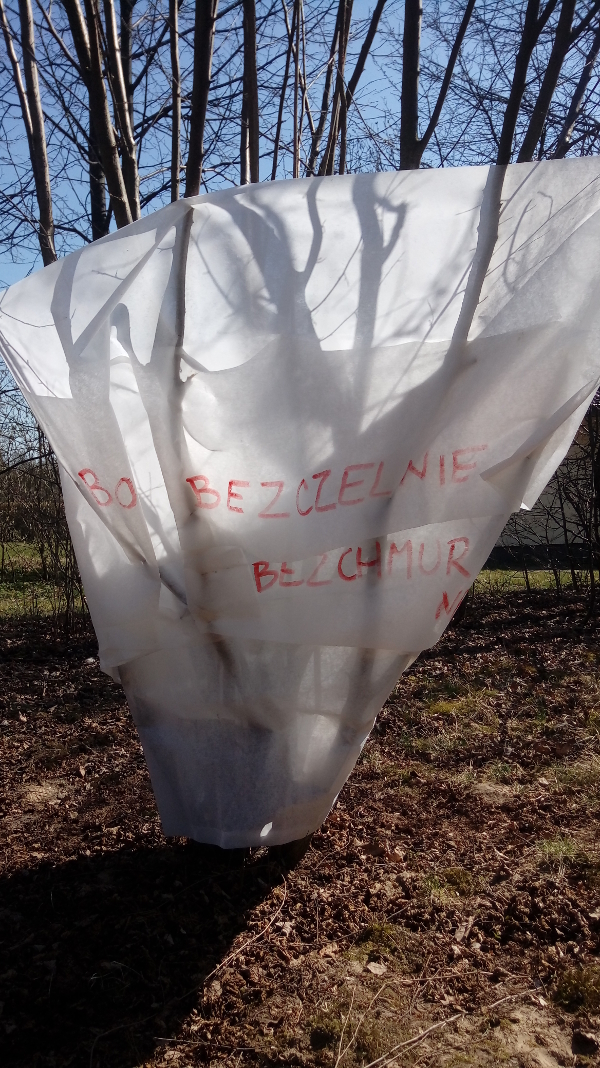 |
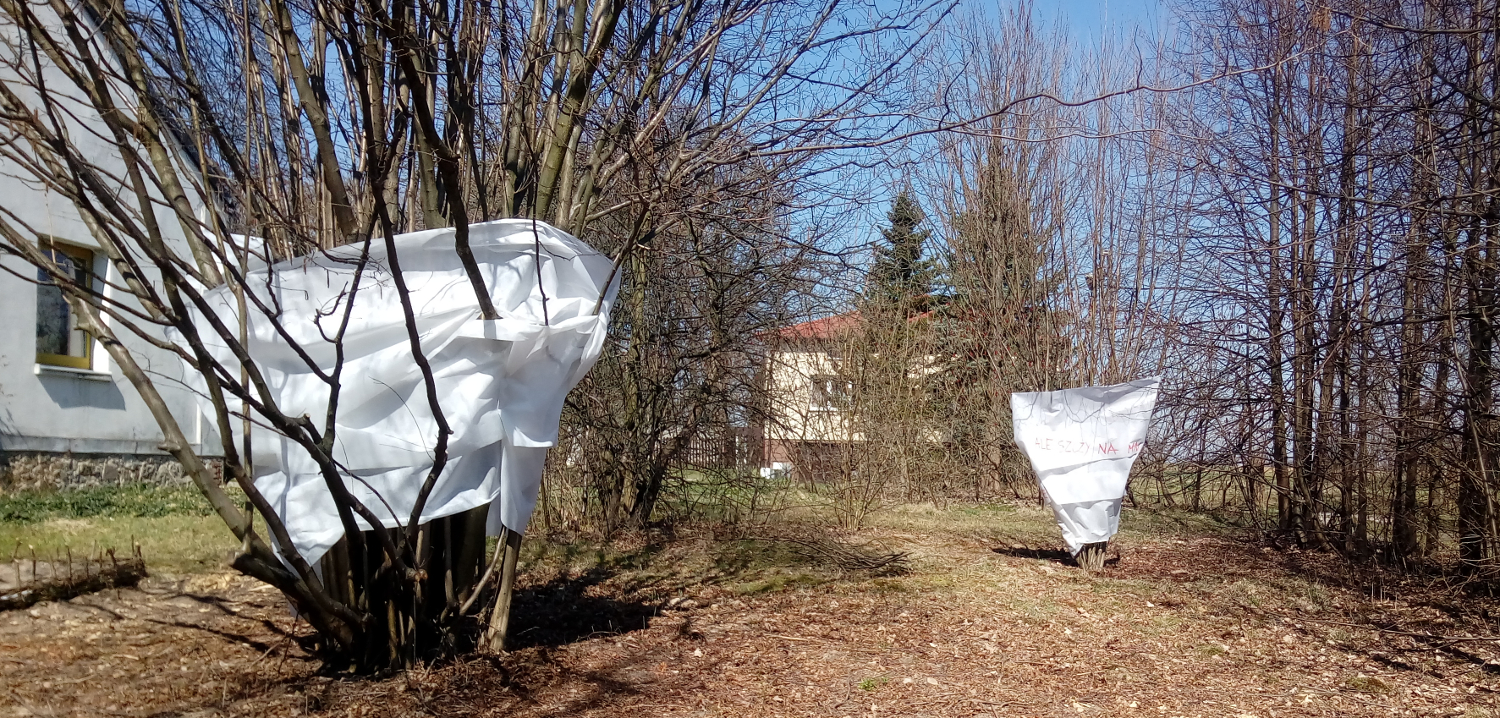
|
The third, the biggest one, was too similar to a pyramid, due to not enough wooden poles. There was also an inconsistency in the lack of end: the band should have bifurcated, like a snake’s tongue, and run in opposite directions, unfortunately it was cut too early, too short, probably due to absent-mindedness – why was the author not careful enough? |
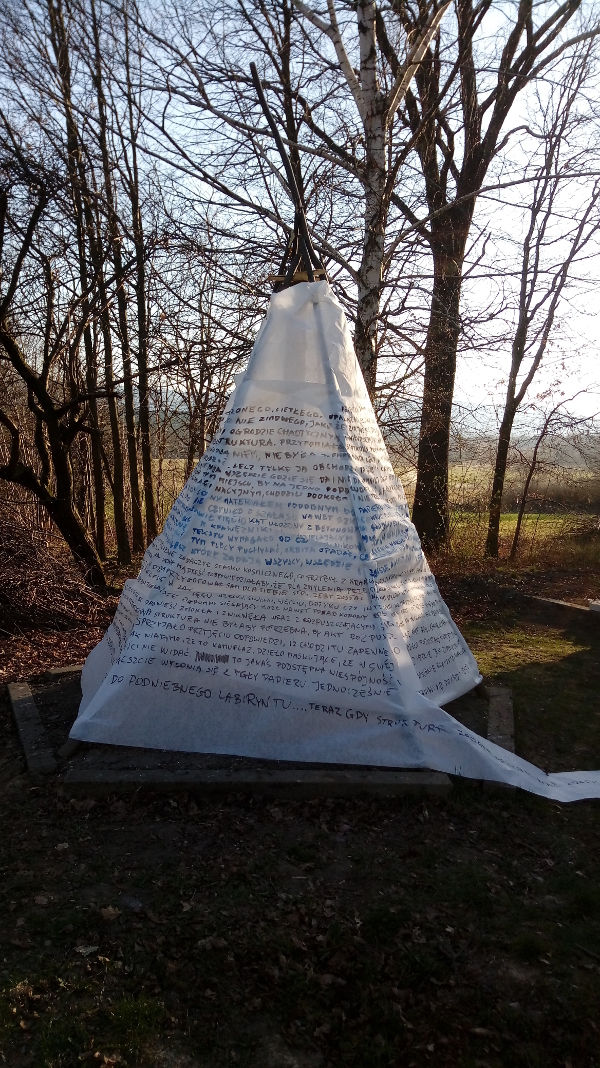 |
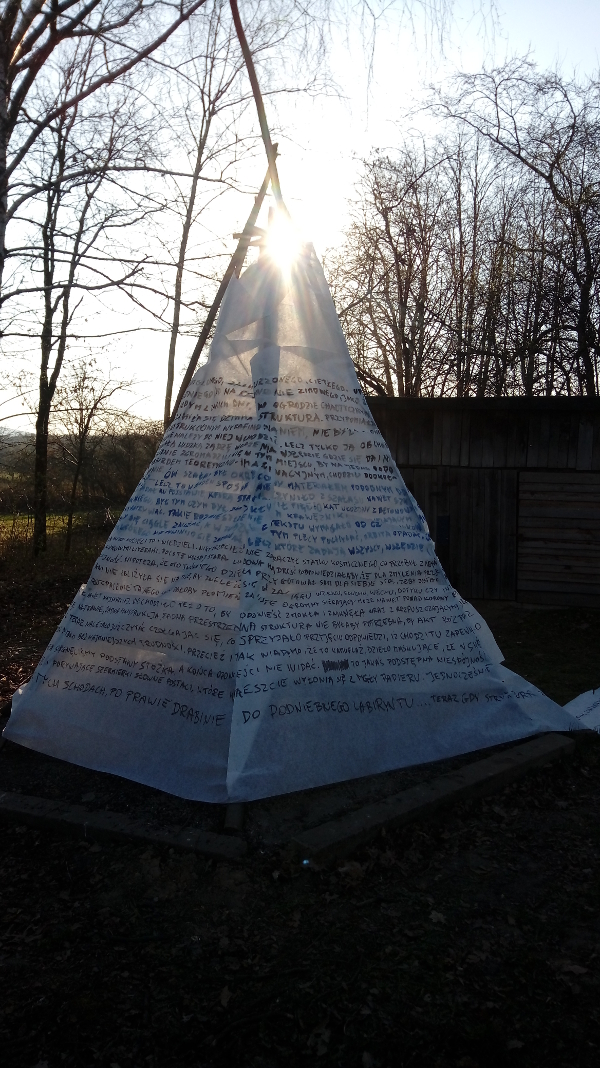 |
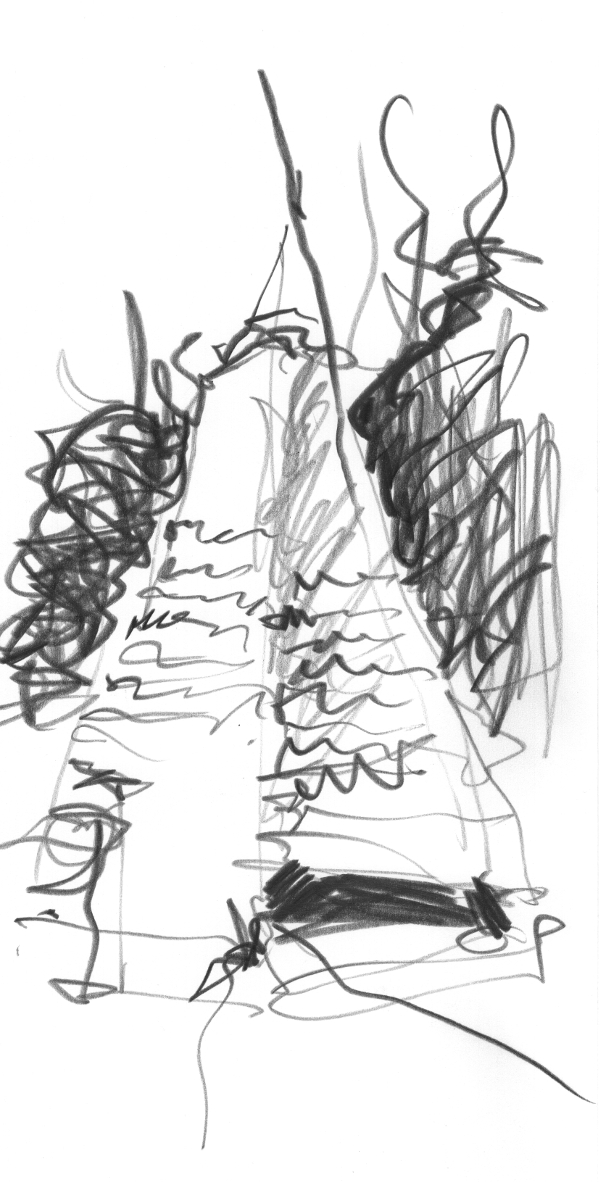 |
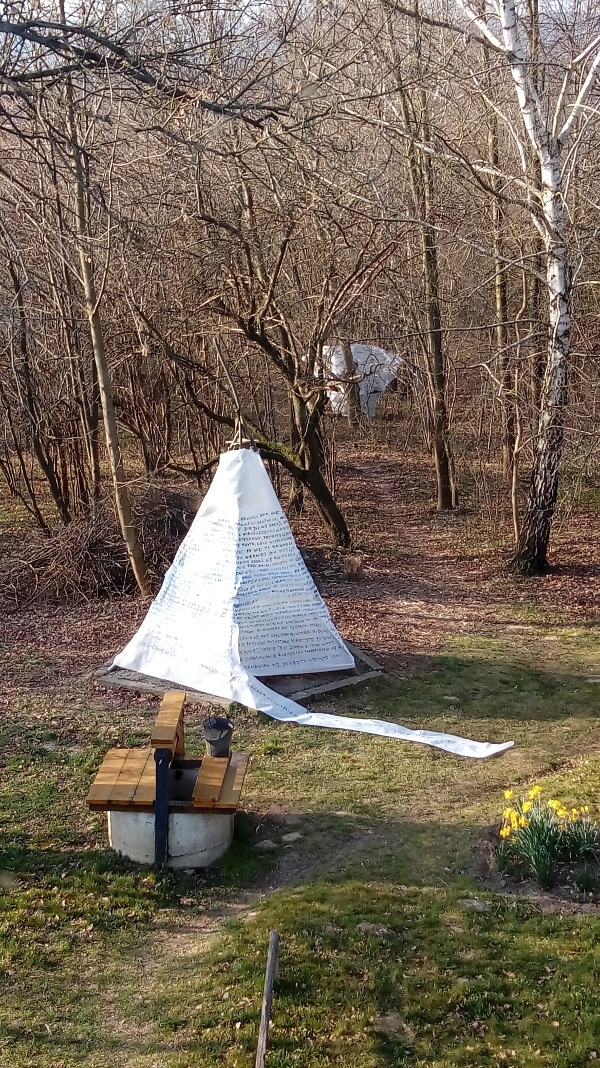 |
|
One day, nobody
knows if sunny, windy, foggy, cloudy, warm, hot,
rainy, nobody knows if spring or summer (with no
doubt not winter, since winters vanished, if not for
ever then for quite some time), not specific day
which can be any of such days, a strange structure
appeared in this chaotic, not neat garden. It
reminded a conical, primitive lodge – a wigwam
compared to it would boast with its sophisticated
construction – however not empty, filled with twigs
and branches, as if wanted to make it clear nobody
should enter it, everybody should walk around it. A
colossal naivety it was to think the degenerated
human desire to to penetrate any possible and
impossible place would be harnessed that way.
Nevertheless, so far the structure succeeded
enormously. The people who gathered here not in
great number to experience just for one afternoon
the immense pleasure, so doubtful for so many
others, of communing with abstraction and absurdity
of theory and imagination, were walking around
showing no desire for any brutal and destructive
acts which only pretend to be delicate and
respectful. The lodge was wrapped by a material
similar to paper and fog – paper is a condensed fog
ensuring infinite erring, isn’t it? - but it has not
made the lodge even a sketchy mock-up of the Tower
of Babel. A text has been written on the band. It
started near the top and ran down spirally to the
base which was a pentagon composed of five concrete
poles that had once been supporting the wooden spans
of ordinary picket fence. The pentagon didn’t
imitate a circle, it was what it was, an ordinary
curb surrounding and protecting the bonfire site,
not a mysterious pentagram that so many people would
like so much to believe and notice. Such stream of
text made the readers to orbit this bizarre book,
however not like planets do orbit the sun, for their
heads had to be lowered and lowered, their backs
leaned more and more, the orbit dropped gradually
causing additional dizziness and chaos. Yes, that’s
right, superfluous, for the basic ones were
generated by the question which shouldn’t be asked,
but everybody, everywhere and always used to ask,
especially in situations like this one: WHAT IS THIS
FOR? The question WHAT IS THIS? didn’t have to be
asked, because everybody could see this, and if saw
then know. Nobody saw there a space vessel that had
arrived form a distant corner of the conical
universe. All could see a stack of almost equally
long hazel boughs thinner than a human arm, wrapped
in whitish textile with colour letters on it. What
are these colours for? An old lore would prompt they
are to mislead the enemy, while another old lore
would add, getting ahead of next question, that the
enemy is everywhere, and everything and everybody
are the enemy, so we need to be vigilant. A
hypothesis, that the author of this work has
prepared the stake for himself to be burnt at it at
his own discretion, not at someone’s, would be
considered absurd, even in this preposterous land;
such an idea has come to nobody’s head, hasn’t even
knock at, approached enough to be seen, heard,
smelled, touched, or detected intellectually. It’s
not the point, either, to burn down ceremoniously
and quasi-ritually a classic work of Tusconian
literature, since this lodge of letters and words
was not such a work. Setting this stake, this pyre,
on fire would cause a flame so high and violent,
reaching even above the tops of the trees growing
here abundantly and lushly. Flames would burn a hole
in the sky, would also devour the whole garden, and
this is what nobody wanted and desired, even most
secretly. It was not the point, either, to make the
tale wet and disappear together with dissolving
letters. It would have been a real downpour, while
they have not been seen here for quite long time,
and should not be expected soon. Well, it would
suffice to spread the paper-fog on the grass, no
construction, no spatial structure would be
necessary, to accomplish the act of dissolving, of
washing away… Pondering these and some other
problems was getting hard and painful because now
the readers had to crawl, almost, which encouraged
them to accept the simplest solution: most probably
this work has been made to be as incomprehensible as
the Phaistos disc – doesn’t matter the Phaistos disc
has not been deciphered yet while the Dolna cone can
be read with no problems at all. Well, it is clear,
this is but a camouflage, a concealing work, which
in its essence is something totally different than
it is, and what it really is we will see, it’s
enough to follow the track, and this track will
guide us nobody knows where to. We have reached the
cone’s base, and we can’t see the tale’s end. This
is a sort of basic incongruence, the parts and
elements of this tale don’t fit each other. How will
the tale unfold? And the readers have begun to
unfold and unroll it expecting exciting actions and
fascinating verbal duels by the characters who would
emerge from the paper-mist; simultaneously kept
pondering where they would be taken to: either deep
into the wild garden, to the sunny meadow and then
to the abyss of huge forest, or to the skyward
labyrinth having climbed before not so sinuous
stairs? . . . . . Especially now, when the structure
looked more and more like a wizard’s cap. Where to?
. . . . . Where to? . . . . . Where is where?
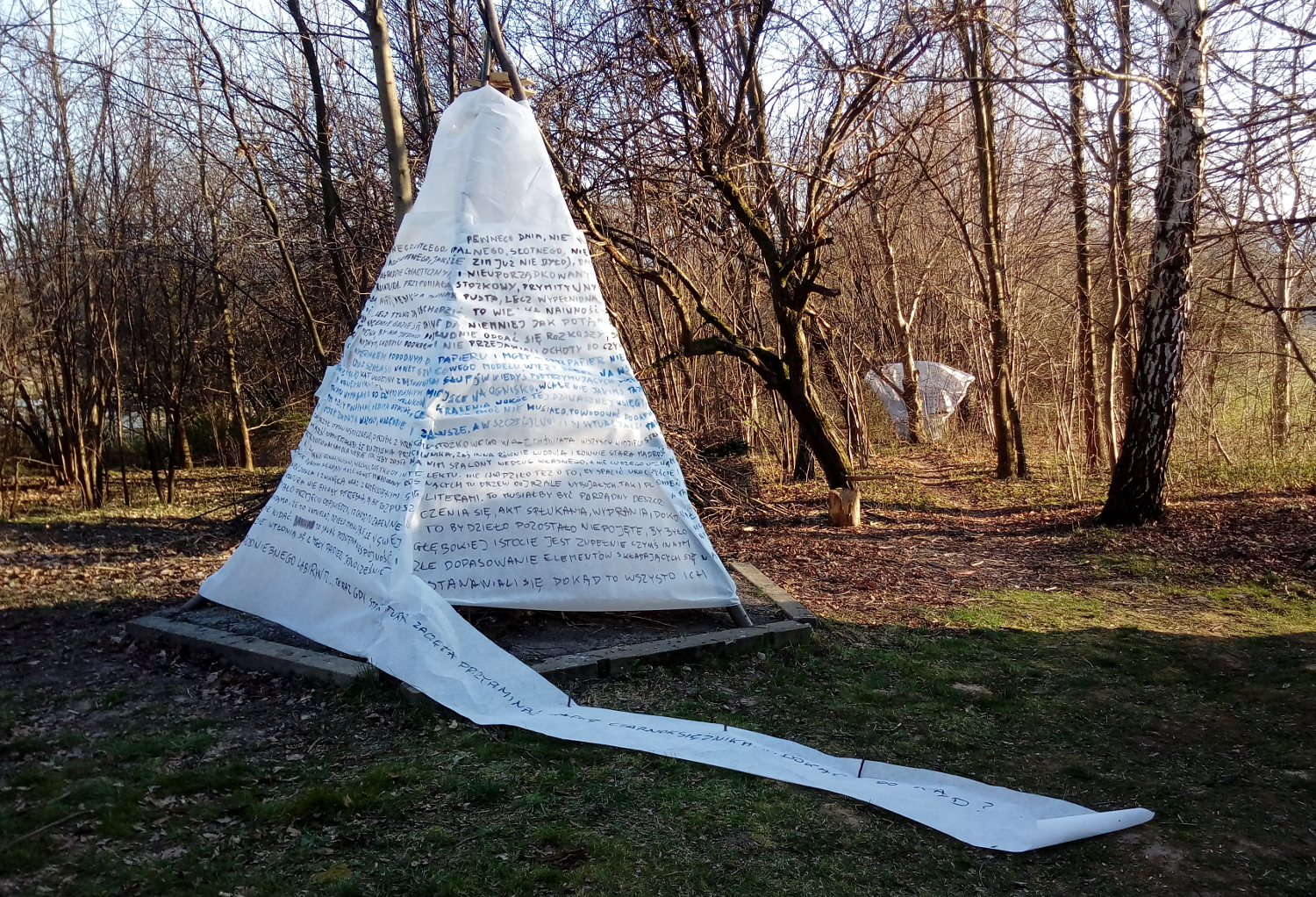 The fourth one was the best. Well, that’s the matter of skills and experience. I wish there were a few more. I wish there were lights, bulbs or candles, inside them – spirits and ghosts of Tuscony would visit in the night the garden waking up to life. |
am I happy, am I not?
hidden in the bushes wrapped by mist of words who can know it? who can not? |
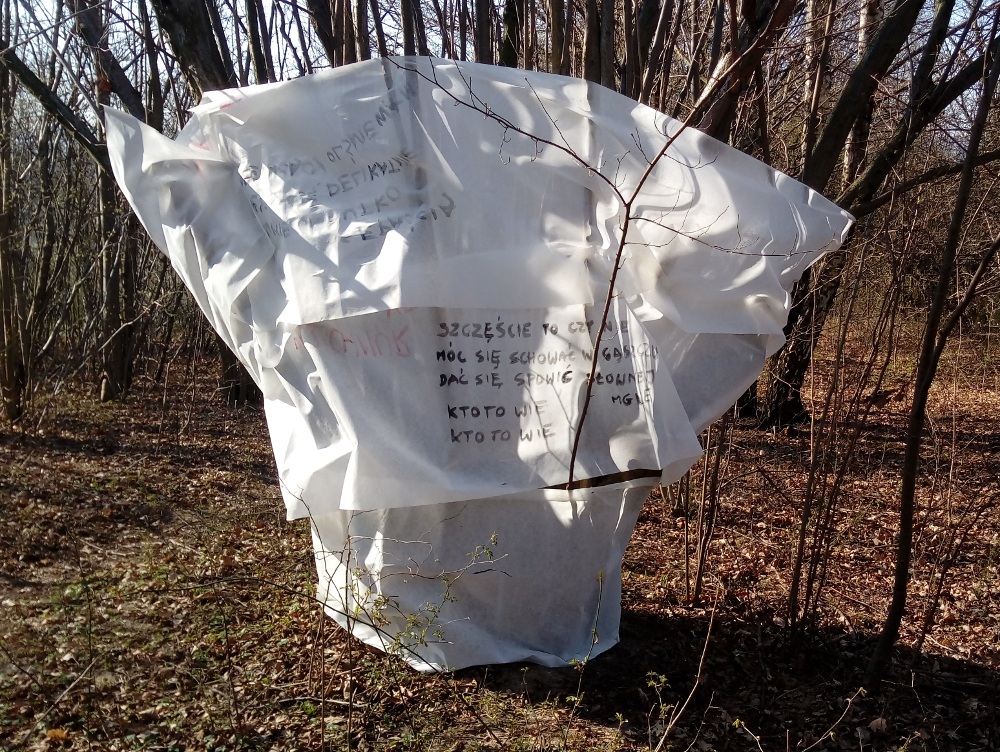 |
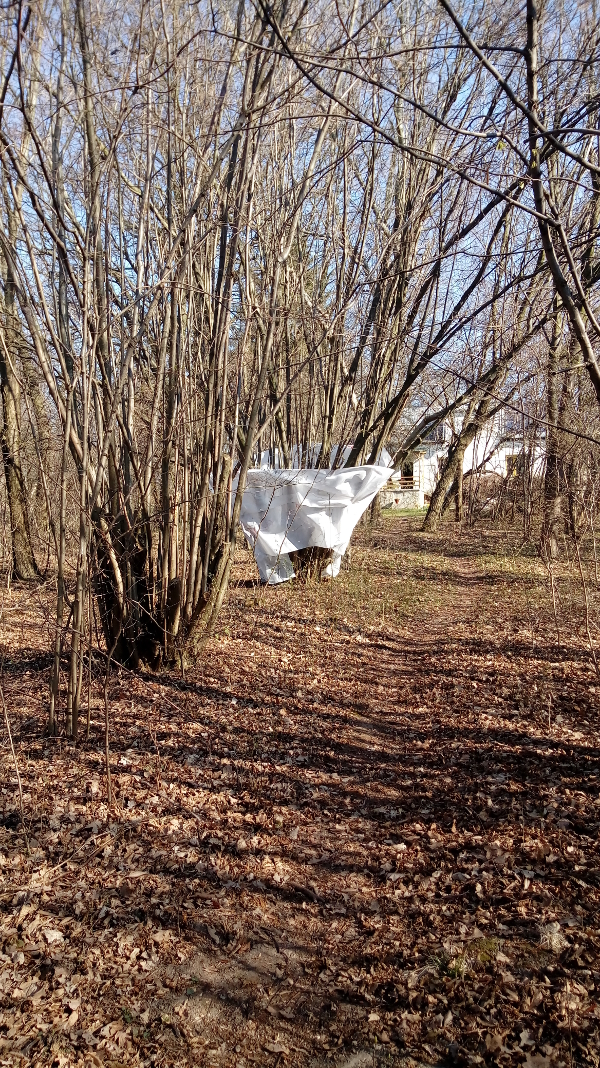 |
|
Thank you very much, my dear non-participants, for your readiness and enthusiasm. |
